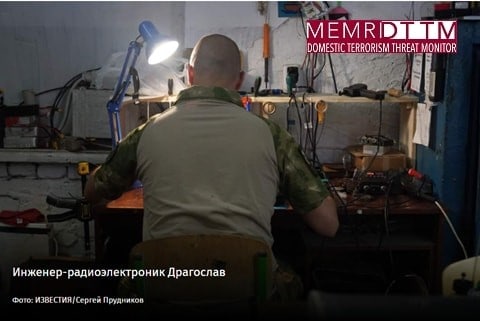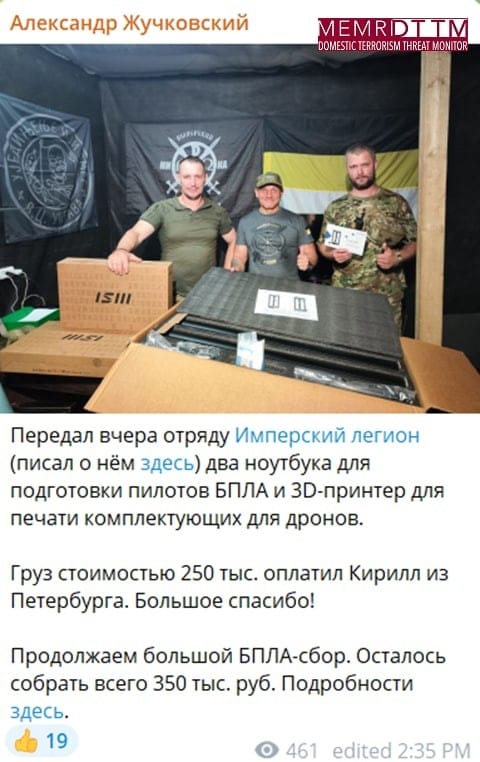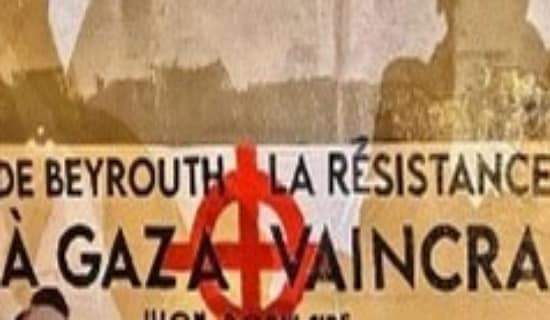On April 6, 2020, the United States Department of State announced the designation of the Russian organization, "Russian Imperial Movement" (RIM) as a terrorist group. It was the first time the U.S. had placed a white supremacist group on the U.S. terrorist list.
Since then, Russian state media avoided mentioning RIM in its reports. However, in June of 2024, "Izvestia" newspaper (which is on the E.U. sanctions list as well) published an interview[1] with a Russian "special mining platoon" comprised primarily of members of the "Imperial Legion." The Imperial Legion is a military wing of RIM, which part took in the war in Donbas, and which currently participates in the hostilities in Ukraine. Despite supporting the hostilities, the RIM continues to criticize Vladimir Putin's policy on social networks.
YOU MUST BE SUBSCRIBED TO THE MEMRI DOMESTIC TERRORISM THREAT MONITOR (DTTM) TO READ THE FULL REPORT. GOVERNMENT AND MEDIA CAN REQUEST A COPY BY WRITING TO DTTMSUBS@MEMRI.ORG WITH THE REPORT TITLE IN THE SUBJECT LINE. PLEASE INCLUDE FULL ORGANIZATIONAL DETAILS AND AN OFFICIAL EMAIL ADDRESS IN YOUR REQUEST. NOTE: WE ARE ABLE TO PROVIDE A COPY ONLY TO MEMBERS OF GOVERNMENT, LAW ENFORCEMENT, MEDIA, AND ACADEMIA, AND TO SUBSCRIBERS; IF YOU DO NOT MEET THESE CRITERIA PLEASE DO NOT REQUEST.
On June 26, 2024, Izvestia newspaper published an article dedicated to a new tactic deployed by Russian troops: mining the territory behind enemy lines with the help of FPV [first person view] UAV drones, often equipped with Soviet-made POM-2 mines.[2] These drones are capable, using special mechanisms, to activate a mine in the air, and then release it. After contact with the ground, the mine discharges its cover, opens and aligns itself vertically, with the help of six petals. Then it spreads treads with anchors, which scatter in a cross pattern up to 10 meters. The mine explodes when the threads are being triggered.[3] In the context of a high demand for UAVs at the front, the advantage of this tactic is that after a successful operation, the drone can return to base and be used for future missions. In addition, fast mining of an enemy's rearguard forces could provide tactical benefits (after being released, POM-2 should be combat-ready in about 50 seconds).
The interview was conducted at the location of the special mining platoon, part of the engineer-sapper battalion named after Karbyshev. The battalion is engaged in hostilities near the Chasovy Yar settlement (Donetsk Oblast, Ukraine). The journalist notes that platoon is comprised of Imperial Legion volunteers, while the commander of the platoon is the man named Denis, with a call sign "Legat."
In the photos, Legat can easily be identified as one of the key RIM figures. Another screen shot shows Denis Gariyev, one of three other RIM leaders who have been designated as Specially Designated Global Terrorists (SDGT) by the U.S. Department of State.[4]

The screenshot depicts the commander of "Legat" platoon, commander of Imperial Legion and prominent RIM member, Denis Valiullovich Gariyev. (Source: Izvestia / Sergei Prudnikov).
Mining drones are being assembled by the platoon itself from available commercial models of FPV UAVs. One of the soldiers interviewed, a Serbian national and radio electronics engineer called Dragoslav, stated that during modification, approximately half of the drone's components had to be changed. In addition, the platoon installs different software for the vehicles: mine-release mechanisms are printed on a 3D printer.

The screenshot depicts platoon member Dragoslav assembling and servicing drones. (Source: Izvestia / Sergei Prudnikov)
The Imperial Legion has a center for tactical and fire training, "Partizan," located in the Russian city of St. Petersburg. The training center provides several military courses related to the use of drones in hostilities: "Combat Drone operator," "Defence against UAVs using radio-electronic reconnaissance means," "Practical Artillery Reconnaissance with UAV," and "Radio-electronic reconnaissance."[5]
The center's website also features a quote by Gariyev concerning the effectiveness of the "Partizan" military training: "This system was created by life itself. Experience in training volunteers for the first and second companies in Little Russia,[7] Syria, Africa..." At the end of the journalist's article, the Legion members again urge readers to "respond quickly and supply to wartime challenges, including technical ones."[6]
According to the "Izvestia" article, the platoon usually conducts 8-10 drone operations per day. It seems that the platoon faces the problem of a lack of UAVs and components at the front. This is evidenced by fund-raising campaigns regularly organized by the Imperial Legion's members. For example, on July 2, another prominent member of the Imperial Legion, writer Alexander Zhuchkovski, started a fundraising campaign on his Telegram account to acquire FPV drones for to "combat UAV platoons fighting in the Donbass." One of them is the Imperial Legion's mining platoon.[8] The other two combat UAV platoons mentioned are the "Eskadron" unit, part of the infamous "Espanola" brigade,[9] and combat unit "Octava."[10] The post noted that the Imperila Legion, in particular, needs two laptops for training UAV pilots and a 3D printer for printing components for drones. In its recruitment efforts, the Imperial Legion also gives priority to UAV operators, as well as to specialists in the field of radio electronics, communications, and software development.[11]

The screenshot of the post by Alexander Zhuchkovski's Telegram channel[12] depicts the commander of the Imperial Legion, Denis Gariev (far left in the image above) posing with laptops and a 3D printer. In the background, from left to right, the flags displayed are: the Serbian Black Hand flag, "Уједињење или смрт" (Unification or Death), the Imperial Legion flag, and the Russian Imperial flags. According to the post, the equipment cost 250 thousand rubbles (about $2,900 USD).
The Imperial Legion's calls to face the challenges of modern warfare quickly and its calls for supplies are, perhaps, evidence of a tough situation at the front. On social media, the Russian Imperial Movement fiercely criticizes and condemns the Russian command, the Kremlin, and Russian President Vladimir Putin directly. The movement perceives the policy of the Kremlin as neo-Bolshevik, and repeats, in its criticism, many conspiracy theories.
One of the most recurring narratives is the "unwillingness" of the Kremlin to wage a "real" war against the West, its desire to abandon goals of the SVO [special military operation in Ukraine][13] and sign a peace settlement. The last is perceived as a President Putin's statement about the absence of plans for an offensive action in the Kharkov Oblast (Ukraine), writing: "Vladimir Putin said that Russia currently bears no plans to capture Kharkov. (...) Moreover, the President of Russia noted that there is a basis for negotiations with Ukraine - the Istanbul agreements. (...) The specter of communism of the Brest Peace[14] is already hovering over our country and only the reluctance of 'respected partners' to accept the skewed 'fair' conditions for the surrender [of Russia] prevents the 'progressive left forces' from finally defeating fascism and building the 'merriest' society on the bones of the Russian people."
On March 28, the RIM claimed[15] that the country's commander-in-chief, Vladimir Putin, was ready to surrender: "He [Vladimir Putin] managed to cast another thought in granite. 'We are not going to fight with NATO.' (...) That is, Putin declared to the whole world that we got scared, we won't fight because we are weak (...) And this is after Western countries organized a monstrous terrorist attack in Krasnogorsk![16] (…) Well, how can one win with such a Commander-in-Chief, ready to surrender in advance?"
In turn, the Telegram channel of the Imperial Legion claimed that Russian officials receive direct instructions from the U.S., while also condemning the West: "Their goal is to kill us. Destroy Russia and Christianity. Bring the Antichrist to power."[17] Later, on July 18, the RIM Telegram channel bluntly accused Putin of having manipulators in the West.[18] The post also lists "globalist projects" that Western countries promote in Russia, executed via obedient governments and presidents: replacement migration (aimed at replacing the Russian ethnic group with migrants from Central Asia); the COVID-19 pandemic; the digital ruble. The text reads: "(…) so, our war is sort of pretend one. While, in fact, we are still committed to building a New World Order and run ahead of the train of our Western masters, leading the Russian people to ritual slaughter."[19]
In the background of calls to modernize the military, ideas circulate of officials being Western "puppets" making a separate peace; possible evidence of a dire situation at the front; problems with army supplies, corruption, and the reluctance of the authorities to change domestic policy in accordance with the expectations of the nationalist groups fighting in Ukraine. These ideas may explain the warmongering stance of the RIM, and may lead to future conflicts with the state authorities: "The Okarina [a slur for Ukraine] as a state must be destroyed, and its territories must become part of Russia. This is the only way Russia will ensure peace and stability on its southwestern borders."[20]
[1] Iz.ru/1718044/sergei-prudnikov/otpravit-zabros-rossiiskie-voennye-osvoili-taktiku-distantcionnogo-minirovaniia
[2] The "Protivopekhotnaya Oskolochnaya Mina – 2" (POM-2) or "Ot'yok" is a Soviet-manufactured fragmentation anti-personnel mine. Each mine wights about 1,6 kilos.
[3] Saper.isnet.ru/mines-2/pom-2.html
[4] 2017-2021.state.gov/designation-of-the-russian-imperial-movement/
[5] Ruspartizan.com/; https://ruspartizan.com/OperatorBoevogoDrona/
[6] Denis Gariev talks about the Legion's participation in the war in Donbass and the war in Ukraine.
[7] Iz.ru/1718044/sergei-prudnikov/otpravit-zabros-rossiiskie-voennye-osvoili-taktiku-distantcionnogo-minirovaniia ;
[8] T.me/juchkovsky/4656.
[9] T.me/hussarsquadron/152.
[10] T.me/juchkovsky/4136.
[11] T.me/imperskiylegion1917/281.
[12] T.me/juchkovsky/4687.
[13] SVO (Specialnaya Voennaya Operaziya) – Special Military Operation in Ukraine.
[14] Meaning the Treaty of Brest-Litovsk - a separate peace treaty between the USSR and the Central Powers signed in 1918 that ended WWI for the Soviet Union.
[15] T.me/Rus_imperia/12360.
[16i] Meaning the terrorist attack on the Crocus City Hall venue that occurred March 22, 2024, in the Russian city of Krasnogorsk. The Russian authorities maintain that Western secret services and Ukraine were involved in the attack.
[17] T.me/imperskiylegion1917/363.
[18] T.me/Rus_imperia/12565.
[19] Ibid.
[20] T.me/Rus_imperia/12578.
The full text of this post is available to DTTM subscribers.
If you are a subscriber, log in here to read this report.
For information on the required credentials to access this material, visit the DTTM subscription page








